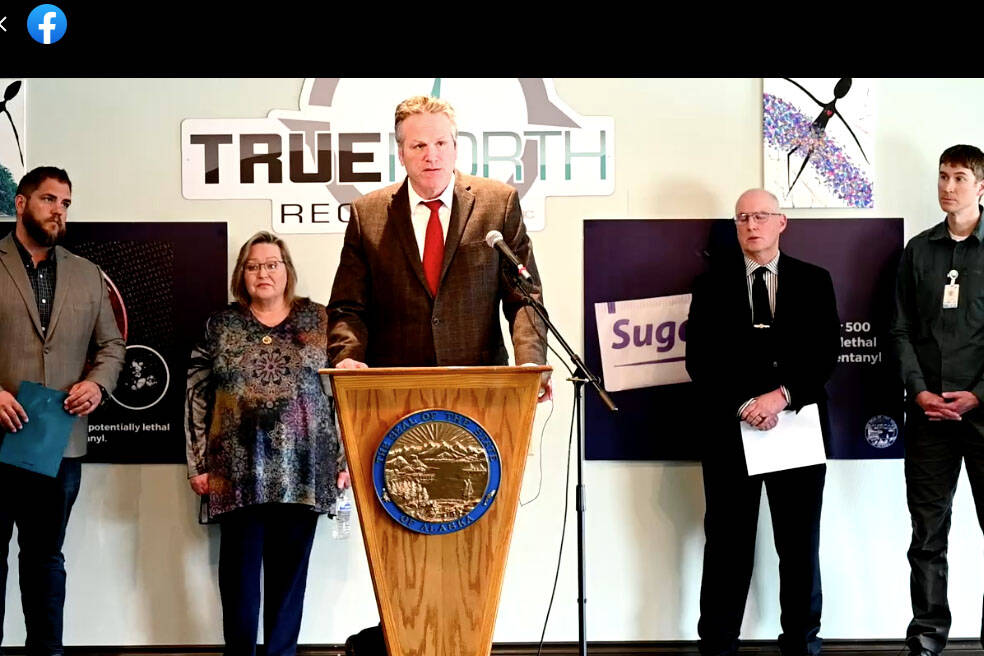Speaking from a recovery facility in Wasilla, Gov. Mike Dunleavy on Tuesday issued a community alert warning Alaskans about the relationship between fentanyl and fatal drug overdoses and detailed his response to the crisis.
Fentanyl is a synthetic opioid that the U.S. Drug Enforcement Administration says is between 80 and 100 times stronger than morphine and is approved for treatment of severe pain. Fentanyl that is illegally made, however, is what’s linked to “most” recent cases of fentanyl harm, overdose and death, according to the U.S. Centers for Disease Control and Prevention.
Drug overdose deaths in Alaska surged by 71% between 2020 and 2021. According to Dunleavy’s office, preliminary data from the Alaska Department of Health and Social Services show that drug overdose deaths in Alaska increased from 146 in 2020 to 253 in 2021. Almost 60% of overdose deaths last year involved fentanyl, a release from the governor’s office said.
Dunleavy on Tuesday attributed Alaska’s spike in drug use to what he said was an “insufficiently protected southern border.” He said he will continue working with other governors to push President Joe Biden “to do more” to stop shipments of fentanyl to Mexico from China.
According to a January 2020 intelligence report by the DEA, Mexico and China are “the primary source countries” for fentanyl and fentanyl-related substances trafficked directly into the United States.
In response to the state’s fentanyl crisis, Dunleavy said people who deal fentanyl will be prosecuted to the “fullest extent of the law,” which includes being charged with manslaughter if someone who ingests the drug dies. He said Tuesday that his office will have conversations with the Alaska Legislature to increase that charge to second-degree murder.
Part of the response to the fentanyl crisis, Dunleavy said, includes reducing stigma around drug addiction and expanding efforts in schools to help students and health care professionals. He said the state is working to expand access to treatment and recovery services.
Dunleavy also unveiled a new bulletin that DHSS Commissioner Adam Crum has been directed to share with schools and parents. That bulletin warns that, in Alaska, fentanyl is commonly seen in blue pills that are meant to look like pharmaceutical oxycodone. Those pills are sometimes called “blues,” “M-30s” or “dirty 30s” and are usually stamped to look like pills dispensed by pharmacists.
“Families need to be educated on the dangers of fentanyl, and that even one pill can be dangerous and even fatal,” the bulletin says.
The bulletin says schools can support families by providing easy access to naloxone, a drug that reverses the effects of an opioid overdose, and by knowing how to recognize an opioid overdose. It cannot be determined whether a pill contains fentanyl just by looking at it.
Signs of an opioid overdose include loss of consciousness, slow or shallow breathing, pale or blue skin, a limp body and constricted pupils, according to the CDC.
Dunleavy said Tuesday that Alaska also received supplies for 11,000 Narcan kits, also known as naloxone, and will step up all enforcement efforts. The National Institutes of Health describes naloxone as an “opioid antagonist,” meaning it attaches to opioid receptors and reverses and blocks the effects of other opioids.
Leaders at a Narcan workshop held in Soldotna last year said to think of opioids like tiny golf balls and someone’s neuron receptors like golf tees. As long as the opioid is active, it sits on the “tee” of someone’s receptors. When the opioid dies, it falls off the receptor and new opioids stick on them. Naloxone knocks all the opioids off their receptor tees.
The drug only has a half-life of about 30 minutes, however. Once it starts dying, opioids rush to fill those tees back up. That’s why it’s so important for the person responding to the overdose to call 911. Pharmacists in Alaska are able to dispense naloxone independently of prescribers.
More information about opioids in Alaska can be found on DHSS’ website at dhss.alaska.gov/dph/Director/Pages/opioids/home.aspx.
Reach reporter Ashlyn O’Hara at ashlyn.ohara@peninsulaclarion.com.
—-Box content—-
If you or someone you love is struggling with substance use, consider reaching out to one of the peninsula’s addiction treatment and recovery centers.
Emergency dispatch: 911
Freedom House sober living, Soldotna: 907-260-3733
Serenity House Treatment Center, Soldotna: 907-714-4521
Cook Inlet Council on Alcohol and Drug Abuse, Kenai: 907-283-3658
Cook Inlet Council on Alcohol and Drug Abuse, Homer: 907-235-8001
Ninilchik Traditional Council Community Clinic, Ninilchik: 907-567-3970
Homer Needle Exchange, South Peninsula Hospital, Homer: 907-235-3436
SeaView Community Services, Seward: 907-224-5257

